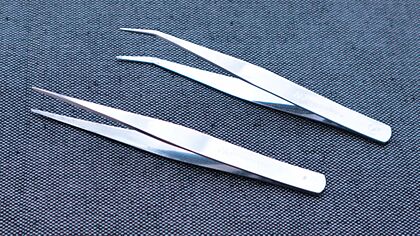Martensitic stainless steel facts for kids
Martensitic stainless steel is a special kind of stainless steel. It gets its name from its unique crystal structure, called martensite. This structure allows the steel to be made very strong and hard through a process called heat treatment. Other main types of stainless steel include austenitic, ferritic, duplex, and precipitation hardened steels.
Contents
How Martensitic Stainless Steel Was Discovered
In 1912, a scientist named Harry Brearley was working in Sheffield, England. He was trying to find a metal that wouldn't rust for gun barrels. During his research, he discovered a new type of stainless steel. This steel could be made very hard and strong.
His discovery was announced to the public in 1915. Later, this special steel was sold under the name "Staybrite". It was even used for the fancy new entrance of the Savoy Hotel in London in 1929.
Around 1890, a German scientist named Adolf Martens was the first to see the unique structure of this steel under a microscope. This structure was later named "martensite" after him. Another inventor, Elwood Haynes, also applied for a patent for a similar stainless steel in 1912.
What Makes It Special?
Martensitic stainless steels are mainly made of iron, with 12% to 17% chromium. Chromium is what makes stainless steel "stainless" because it helps prevent rust. They also contain carbon, which can range from a small amount (0.10%) to a lot (1.2%).
- If they have less carbon (around 0.4%), they are used for things that need to be strong. Examples include parts for pumps, valves, and shafts.
- If they have more carbon (above 0.4%), they are very good at resisting wear and tear. This makes them perfect for items like cutlery (knives and forks), surgical blades, and molds for plastic.
Some types of martensitic stainless steel also contain nickel. Nickel can make the steel even tougher and more resistant to rust. For example, a type called EN 1.4313 (CA6NM) has low carbon, 13% chromium, and 4% nickel. This steel is very strong and easy to work with. It's used for almost all the huge hydroelectric turbines around the world, including those at the "Three Gorges" dam in China!
Sometimes, other elements like boron, cobalt, niobium, or titanium are added. These additions help the steel perform well at very high temperatures, like in parts of steam turbines.
One special type is called Type 630 (also known as 17-4 PH). This steel gets extra strong when it's heated to about 475 degrees Celsius (887 degrees Fahrenheit). This process is called "precipitation hardening."
How It's Made Strong
Martensitic stainless steels can be made much harder and stronger through a process called heat treatment. This usually involves:
- Quenching: Heating the steel to a very high temperature and then quickly cooling it down. This rapid cooling creates the martensite structure.
- Tempering: After quenching, the steel is heated again to a lower temperature and then cooled slowly. This step makes the steel less brittle and more tough, while still keeping it hard.
Think of it like baking a cookie. Quenching is like quickly baking it to get the basic shape. Tempering is like letting it cool down slowly to make it just right – not too hard, not too soft.
Steel that has been quenched and tempered is very strong and tough. This is why it's often used for medical tools like scalpels and razors.
What Is It Used For?
Martensitic stainless steels are used in many different ways because they are strong and resist rust.
Common uses include:
- Parts for pumps and valves
- Boat shafts
- Cutlery (knives, forks, spoons)
- Medical tools (like scalpels, razors, and clamps)
- Ball bearings
- Molds for making plastic items
- Brake disks for bicycles and motorbikes
These steels are very useful in everyday life and in many important industries!


